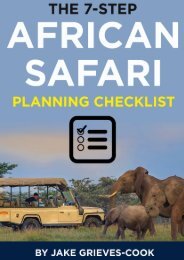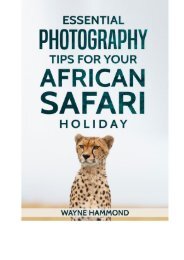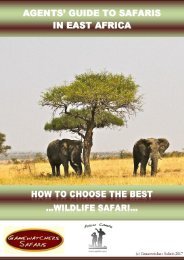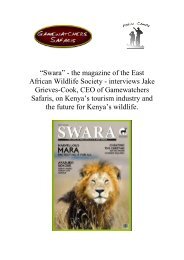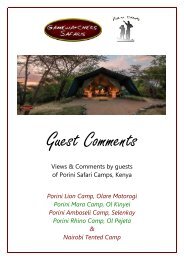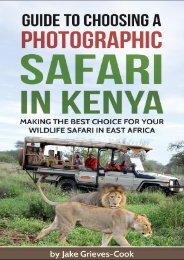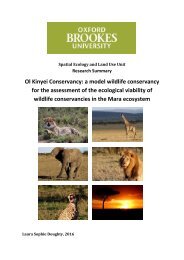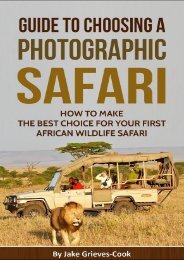How To Make The Best Choice For Your African Safari
A Guide to Choosing the Best African Wildlife Safari - where to go, what type of accommodation and transport to consider and how much it will cost.
A Guide to Choosing the Best African Wildlife Safari - where to go, what type of accommodation and transport to consider and how much it will cost.
Create successful ePaper yourself
Turn your PDF publications into a flip-book with our unique Google optimized e-Paper software.
QUESTION #7: What are the main questions people<br />
ask when planning a trip and what are the answers?<br />
Q: When is the best time to go<br />
to Kenya?<br />
ANSWER: Kenya is on the equator<br />
and is a “year round destination”.<br />
<strong>The</strong> hottest months are January to<br />
March while the coolest are July and<br />
August. <strong>The</strong> two rainy seasons are<br />
from end March to early June<br />
(known as “the long rains”), and<br />
during November and December<br />
(the “short rains”).<br />
Normally it does not rain every day<br />
in the rainy seasons. When it rains<br />
it tends to be mainly at night or in<br />
the early morning so there can still<br />
be sunny days in between. All the<br />
wildlife is still present and many<br />
have their young to co-incide with<br />
the onset of the rains as the<br />
vegetation is lush so there is better<br />
grazing.<br />
Global weather patterns are<br />
changing and sometimes the rains<br />
fail completely in some parts of<br />
Kenya and there is a period of<br />
drought or there may be heavy<br />
rains outside the normal season.<br />
Many safari camps close during May<br />
when the rains are at their height,<br />
as the tracks and roads get muddy.<br />
During the hot months of January<br />
to March conditions can often be<br />
dry and dusty and the animals may<br />
congregate near water-holes so that<br />
there is excellent wildlife viewing.<br />
<strong>The</strong> wildebeest migration moves<br />
into the Mara from the Serengeti<br />
between July and September and<br />
this is when many visitors come to<br />
Kenya and the parks can get more<br />
crowded with tourist vehicles.<br />
<strong>To</strong> sum up – January to March:<br />
usually hot and dry and great for<br />
wildlife viewing, April-May:<br />
likelihood of rain, June: green and<br />
lush after the rains, Jul-August:<br />
cooler but good for the migration in<br />
the Mara, September-October: good<br />
weather and good wildlife viewing,<br />
November – early December: the<br />
short rains.<br />
Q: What is a safari shower /<br />
"bucket" shower?<br />
ANSWER: <strong>Safari</strong> / bucket showers<br />
are common in mobile or tented<br />
camps where there is no permanent<br />
plumbing. <strong>The</strong>y are an effective yet<br />
environmentally friendly way to<br />
shower where water is at a<br />
premium and provide plenty of hot<br />
water to wash comfortably.<br />
Generally there is an en suite<br />
private shower stall within your tent<br />
with a “rainfall” style shower head<br />
at which you can control the water<br />
flow.<br />
Outside the tent there is a large<br />
canvas bag or bucket which is filled<br />
with about 10 to 15 litres (5 US<br />
gallons) of hot water before being<br />
raised with a pulley rope system to<br />
connect to the shower pipe. <strong>The</strong><br />
water is delivered at the ideal<br />
temperature so it is best to use it as<br />
soon as it arrives. Staff fill the<br />
showers at a pre-arranged time of<br />
day, or you can give them a few<br />
minutes’ notice so they can get it<br />
ready.







